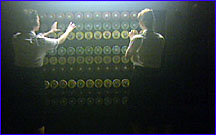
|
 |
 |
 Mind of a Codebreaker
Mind of a CodebreakerPart 3 | Back to Part 2 Turing's machines To try to break the German naval Engima, Alan Turing invented a machine known as the Banburismus, which the codebreakers used to identify enciphered messages with common elements. This, in turn, helped to focus codebreakers' efforts and cut down on the time required on the "bombes." Forerunners of the modern computer that Turing also designed, bombes helped users investigate wheel choice, ring position, and other Enigma settings very rapidly to determine whether cribs or Cillis that the codebreakers thought might be in use actually were. The aim was to find points in a number of messages where a sequence of the machine coincided. If there were two messages with the indicators equating, for example, to the starting points XYK and XYM, with two letters between them, then the second message would start two spaces on. So if the initial letter of the second message was moved to a position over the third letter of the first message, then the letters in each column would be encoded in the same position. This would show up in an unusual number of repeats. Because more of these letters would have been common German letters like E and N, there would be more repeats than in a random position. Alan Turing devised a scoring system which measured the probability of the different positions. The more repeats there were the more likelihood there was of the two sequences having been enciphered in the same position, said Peter Twinn.  If you're lucky and you're lucky pretty frequently, you
might come across a four- or five-letter repeat. You would
say to yourself "a five-letter repeat, it's greatly against
the odds, there must be a reason for it, what is it?" and
the answer is that it represents the encodement of the same
German word in both messages and you might be able to make a
reasonable guess at what it was, having seen some German
messages enciphered in the past.
If you're lucky and you're lucky pretty frequently, you
might come across a four- or five-letter repeat. You would
say to yourself "a five-letter repeat, it's greatly against
the odds, there must be a reason for it, what is it?" and
the answer is that it represents the encodement of the same
German word in both messages and you might be able to make a
reasonable guess at what it was, having seen some German
messages enciphered in the past.So that would give you a little start and then you would try and fit a third message on and you might find with a bit of luck that when you staggered it off with both of them, you might find that this third message had two trigrams, one clicked with one of your messages and another trigram clicked with three in a quite different place on the first message. I'm leaving out a lot of the difficulties, but you gradually build up a selection of 12 or 15 messages out of the day's traffic, which, if you make some other guesses, and if you're very, very lucky, you can do one of a number of things. You can for a start cut down the number of wheel orders the bombes need to check. But you can also either find out the wiring of a brand new wheel or you can work out with a reasonable degree of accuracy what these messages might be saying. Excerpted with permission from Station X: Decoding Nazi Secrets, by Michael Smith (New York: TV Books, 1999). Crack the Ciphers | Send a Coded Message | A Simple Cipher Are Web Transactions Safe? | Mind of a Codebreaker | How the Enigma Works Resources | Teacher's Guide | Transcript | Site Map | Decoding Nazi Secrets Home Editor's Picks | Previous Sites | Join Us/E-mail | TV/Web Schedule About NOVA | Teachers | Site Map | Shop | Jobs | Search | To print PBS Online | NOVA Online | WGBH © | Updated November 2000 |